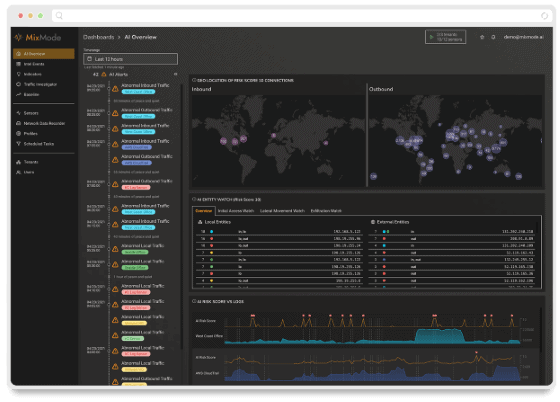MixMode Threat Research is a dedicated contributor to MixMode.ai’s blog, offering insights into the latest advancements and trends in cybersecurity. Their posts analyze emerging threats and deliver actionable intelligence for proactive digital defense.

One of the biggest challenges organizations face today is detecting malicious activity in cloud environments. As highlighted in MixMode’s latest Threat Research Report, cybercriminals are increasingly leveraging trusted cloud providers like AWS, Microsoft Azure, and Google Cloud to disguise their attacks, a strategy known as infrastructure laundering. This allows them to blend in with legitimate traffic, evade traditional security measures, and exploit gaps in cloud authentication and monitoring.
The Rise of Infrastructure Laundering
A key example of this tactic is the Funnull Network, a cybercriminal operation linked to Chinese threat actors. This network has been abusing cloud infrastructure to execute fraud, phishing campaigns, and illicit financial transactions. By using cloud-based resources, these attackers benefit from:
- Legitimacy: Cloud-hosted services are inherently trusted.
- Scalability: Cloud infrastructure allows for rapid expansion.
- Evasion: Dynamic IPs make traditional geolocation filtering ineffective.
- Affordability: Pay-as-you-go models make cybercrime cost-efficient.
Cloud providers often struggle to detect and prevent this abuse, as traditional identity verification methods can be circumvented using stolen credentials, fake business entities, and cryptocurrency payments.
Geolocation is No Longer a Reliable Risk Indicator
For years, security teams relied on geolocation data to flag suspicious activity. But as attackers exploit global cloud environments, location alone is no longer a reliable risk indicator.
Take TikTok’s recent cloud migration as an example. Moving data to less-regulated cloud environments introduces security risks such as:
- Potential user tracking and surveillance
- Unclear data sovereignty, complicating access control
- Increased risk of algorithmic manipulation
This shift highlights why security strategies must go beyond geolocation and focus on behavioral analytics.

AI-Powered Reconnaissance: DeepSeek Exploits
Cybercriminals are also deploying AI-driven techniques like DeepSeek exploits to infiltrate cloud environments. These tactics allow attackers to:
- Identify misconfigured AWS S3 buckets
- Discover exposed authentication keys on platforms like GitHub
- Mimic legitimate cloud services to evade detection
Additionally, collaboration tools such as Slack, Trello, and Discord are being weaponized for cybercrime, serving as covert command-and-control (C2) channels for exfiltrating sensitive data and automating attacks.

The Flaws in Traditional Security: Trust Assumptions and OAuth Exploits
Many of these tactics tie back to OAuth security risks. Attackers exploit OAuth tokens to bypass access controls, maintaining persistent unauthorized access across cloud applications.
Both infrastructure laundering and OAuth exploits share a fundamental weakness: trust assumptions. Security tools often fail to continuously validate authenticated sessions, particularly in Zero Trust environments where token monitoring is overlooked.
The Future of Cloud Security: AI-Driven Behavioral Analytics
Instead of relying on static indicators like geolocation, security teams must shift to behavioral analytics to detect abnormal activity. Key indicators include:
- Unusual access patterns
- Anomalous API usage
- Sudden spikes in data exfiltration
How MixMode Detects Emerging Cloud Threats
MixMode’s self-learning, AI-driven security platform is designed to detect and mitigate modern cloud threats in real time. Unlike legacy SIEMs that depend on static rules, MixMode dynamically adapts to evolving attack patterns by continuously learning from data.
Key Capabilities of MixMode’s AI:
- Real-Time Anomaly Detection – Identifies deviations that indicate OAuth or infrastructure laundering exploits.
- Cross-Domain Data Correlation – Integrates CloudTrail logs, network traffic, and API activity for comprehensive threat detection.
- User Behavior Analytics – Distinguishes legitimate access from malicious activity.
- Zero Trust Reinforcement – Continuously monitors OAuth tokens to ensure session integrity.
Proven Results: A Case Study in Financial Services
A large financial services institution deployed MixMode to combat cloud-based authentication and API abuse. The outcome?
- 96% reduction in false positives
- Real-time detection of OAuth-based session hijacking
- Actionable insights without overwhelming security teams
Staying Ahead of Cloud-Based Threats
The cybersecurity landscape is changing, and organizations must evolve to keep up. As attackers refine their techniques, proactive behavioral monitoring is the key to detecting hidden threats before they escalate.
Download MixMode’s latest Threat Research Report to learn how AI-driven security can protect your organization from emerging cloud threats.
Download the Full Threat Report Here:
Hiding in Plain Sight: Why Geolocation Data is One of Many Risk Indicators in Cloud Environments
Other MixMode Articles You Might Like
Securing OAuth Authentication Risks with AI-Driven Monitoring
Why DeepSeek’s Low Price Could Cost You Everything
Codefinger Ransomware: Detection and Mitigation Using MixMode
Six Friends Every Security Team Needs
Threat Research Recap: Paving the Way for Smarter Defense Tech in 2025

